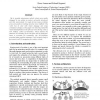Free Online Productivity Tools
i2Speak
i2Symbol
i2OCR
iTex2Img
iWeb2Print
iWeb2Shot
i2Type
iPdf2Split
iPdf2Merge
i2Bopomofo
i2Arabic
i2Style
i2Image
i2PDF
iLatex2Rtf
Sci2ools
ICRA
2003
IEEE
2003
IEEE
3D-odometry for rough terrain - towards real 3D navigation
Up to recently autonomous mobile robots were mostly designed to run within an indoor, yet partly structured and flat, environment. In rough terrain many problems arise and position tracking becomes more difficult. The robot has to deal with wheel slippage and large orientation changes. In this paper we will first present the recent developments on the off-road rover Shrimp. Then a new method, called 3D-Odometry, which extends the standard 2D odometry to the 3D space will be developed. Since it accounts for transitions, the 3D-Odometry provides better position estimates. It will certainly help to go towards real 3D navigation for outdoor robots.
Autonomous Mobile Robots | ICRA 2003 | Large Orientation Changes | Off-road Rover Shrimp | Robotics |
| Added | 04 Jul 2010 |
| Updated | 04 Jul 2010 |
| Type | Conference |
| Year | 2003 |
| Where | ICRA |
| Authors | Pierre Lamon, Roland Siegwart |
Comments (0)

